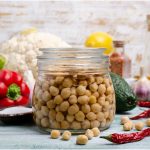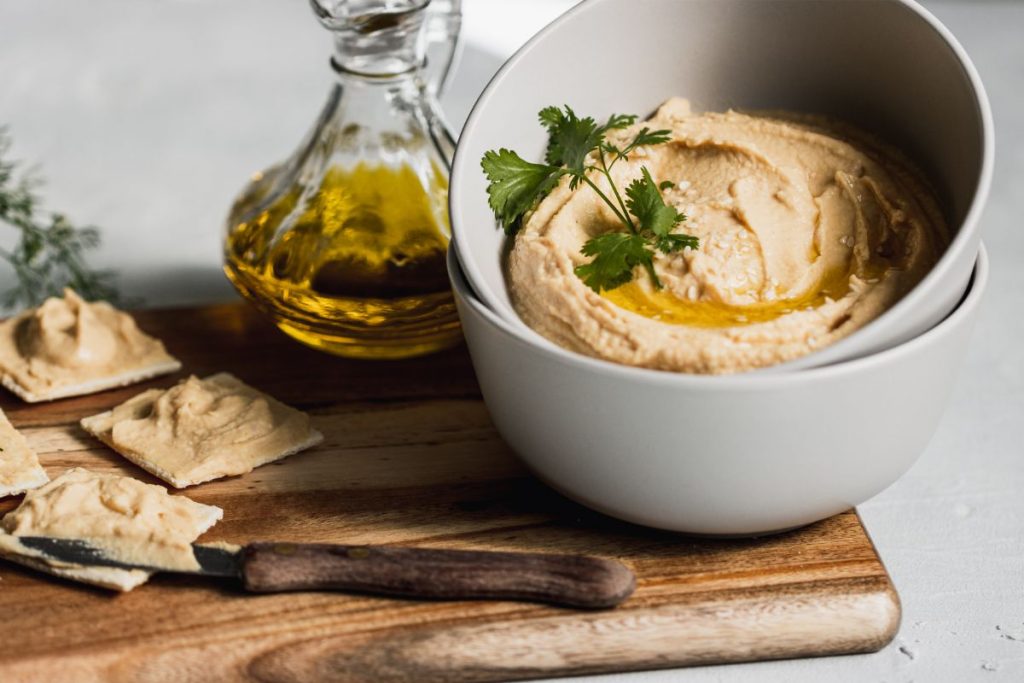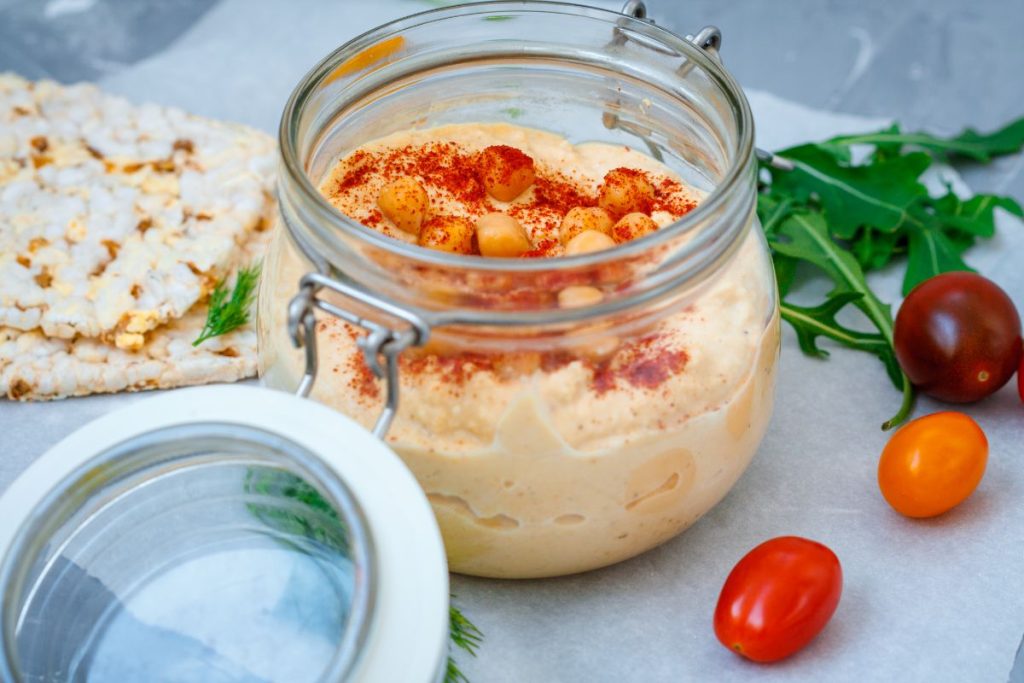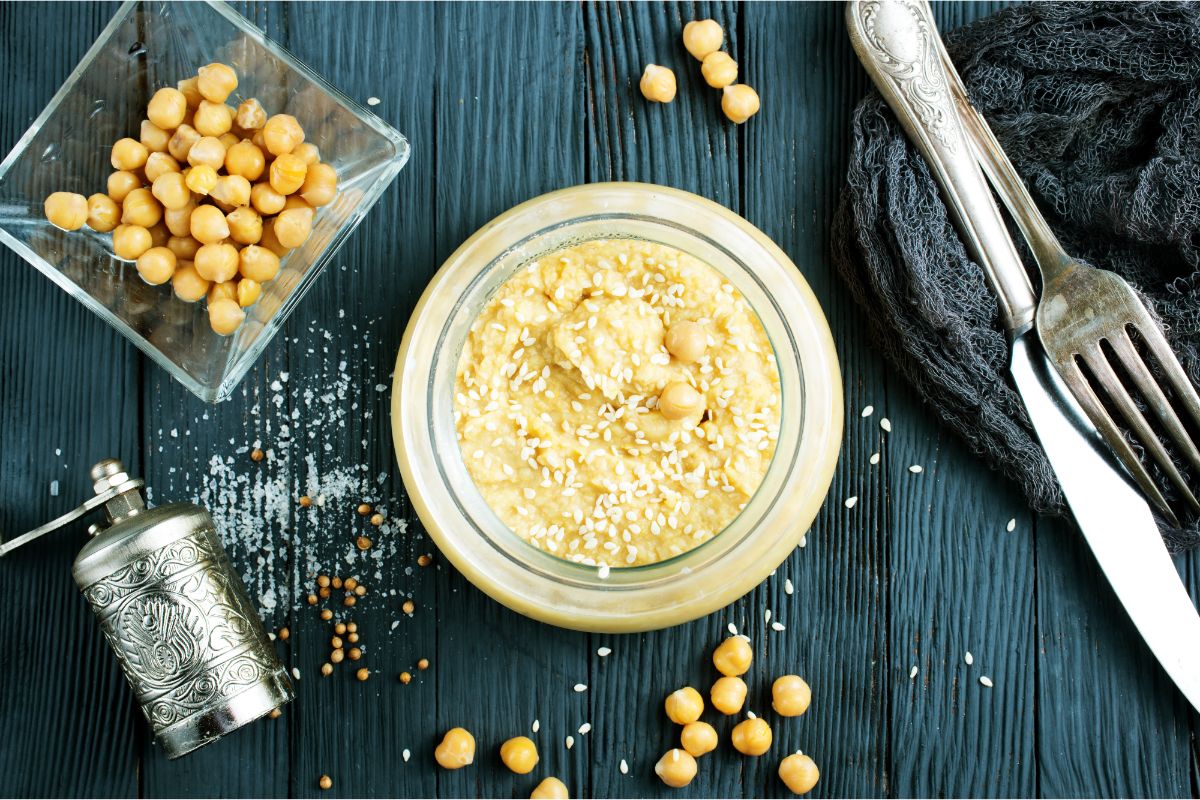Canning prepared hummus is not advised, but it is possible to can garbanzo beans. To can garbanzo beans, soak them in water overnight and boil the beans for 30 minutes. Hot pack the beans into canning jars and process in a pressure canner for 75-90 minutes.
Is it Safe to Can Hummus?
It is impossible to safely can hummus because it has a paste-like consistency. Heat can’t successfully penetrate through the middle of the canning jar, even when pressure canning. There is currently no safe home canning method that can reliably attain the required temperatures for canning hummus.
However, it is safe to can chickpeas or garbanzo beans, which are the main ingredient used to make hummus. Garbanzo beans offer a wealth of protein, fiber, and other essential nutrients and can be blended with oil and spices to make hummus.
Print
Canning Recipe for Chickpeas or Garbanzo Beans
- Total Time: 2 hours, 15 minutes
- Yield: 9 pints 1x
Description
If you want to preserve delicious chickpeas or garbanzo beans to make hummus or simply as a savory side dish, this canning recipe has you covered!
Ingredients
- 3lbs, 6 ounces of dried chickpeas
- Water
- Salt (optional)
Instructions
- Dried chickpeas must be soaked before canning. You can quick-soak the dried chickpeas by boiling them for 2 minutes and letting them rest in the hot water for an hour. You can also opt to cover the chickpeas in a bowl with water and let them sit overnight.
- Drain the soaking water and discard it.
- Boil the chickpeas in a pot of fresh water for 30 minutes. Drain the cooking liquid and set it aside.
- Pack the cooked chickpeas into hot, sanitized canning jars, leaving at least 1 inch of headspace.
- Add ½ teaspoon of kosher salt, per pint jar.
- Fill the jars using the cooking water you boiled the chickpeas in, maintaining 1 inch of headspace.
- Use a bubble popper tool to remove all the trapped air from the jars.
- Use a damp kitchen cloth to wipe the jar rims. Place a new caning lid on each jar and apply screw bands until fingertip tight.
- Prepare the pressure canner per the manufacturer’s instructions by adding 2-3 inches of water and a canning rack inside.
- Use a jar lifter to transfer the jars of garbanzo beans or chickpeas into the prepared canner.
- Close the lid and open the vent pipe and bring the water inside to a boil over high heat. Allow the canner to vent steam steadily for 10 minutes before closing the pipe and letting the pressure build to between 10 and 15 PSI, depending on elevation and canner type.
- Place the jars in the pressure canner and process pints for 75 minutes and quarts for 90 minutes.
Dial-Gauge Pressure Canner
- 0 – 2,000ft: 11 lbs
- 2,001 – 4,000ft: 12 lbs
- 4,001 – 6,000ft: 13 lbs
- 6,001ft and up: 14 lbs
Weighted Gauge Pressure Canner
- 0 – 1,000ft: 10 lbs
- 1,001ft and up: 15 lbs
Post Processing
- Once the time is up, turn off the canner. Allow the pressure to return to zero.
- Open the canner carefully, pointing away from your face and allow the jars to sit in the canner for an additional 5 minutes.
- Remove the jars using canning tongs and transfer them to a cushioned countertop to cool for 12-24 hours.
- Test the seals of the jars by pressing on the lids and ensure the lids do not flex up and down. Any lids that flex mean the jar is not sealed and must be refrigerated and eaten within 3-5 days.
- All correctly sealed jars should be labeled with the contents and canning date, and stored in a cool, dry, dark place for up to 1 year.
- Prep Time: 15 minutes
- Cook Time: 2 hours
Nutrition
- Serving Size: 1/2 cup
- Calories: 134kcal
- Sugar: 3.9g
- Sodium: 6mg
- Fat: 2.1g
- Saturated Fat: 0.2g
- Carbohydrates: 22.5g
- Fiber: 6.2g
- Protein: 7.3g
- Cholesterol: 0g
Is it Better to Pressure Can or Water Bath Can Chickpeas and Garbanzo Beans?
Pressure canning is the most suitable method for canning chickpeas. Chickpeas are low-acid foods that may have spores that can lead to foodborne illness, including botulism.
The high temperature reached during pressure canning is required to destroy the botulism bacteria spores and ensure the safety of the canned chickpeas. Water bath canning is not a recommended method of canning chickpeas.
How to Make Hummus from Canned Chickpeas or Garbanzo Beans
It’s quick and simple to make hummus using canned chickpeas or garbanzo beans.
- Drain the canning water and rinse the chickpeas thoroughly under cold running water. This helps to improve the flavor and remove any excess salt.
- Add the drained chickpeas, lemon juice, minced cloves of garlic, extra-virgin olive oil, tahini, ground cumin, and a pinch of salt to a food processor or blender. You may adjust the amount of the ingredients used to your preference or follow a hummus recipe.
- Grind the ingredients until they make a smooth and creamy paste. Scrape down the sides of the blender occasionally to ensure that everything is combined. Add a tablespoon of water at a time if the mixture appears too thick until you reach your desired consistency.
- Taste the hummus and, if necessary, add salt or fresh lemon juice to your liking. You can also enhance the flavor by adding other veggies, herbs, or spices like roasted red peppers, paprika, or fresh parsley.
- Transfer your hummus to a serving bowl and drizzle with olive oil and other toppings for added flavor and to enhance the presentation.
- Serve the homemade hummus with pita bread, tortilla chips, or raw vegetables.

What Size Jars Should Be Used for Canning Garbanzo Beans or Chickpeas?
When canning garbanzo beans, you should use pint-sized jars or ½-pint jars.
Are Chickpeas Different than Garbanzo Beans?
No – garbanzo beans and chickpeas are used interchangeably and refer to the same thing. The word “chickpea” is widely used in Canada and the United States. They are often referred to as garbanzo beans in Spain and Latin America.
What are the Benefits of Canning Garbanzo Beans or Chickpeas?
- Convenience: Canned chickpeas offer a ready-to-use ingredient; drain and rinse them before using.
- Improves digestion and controls blood sugar levels: Fiber from chickpeas helps reduce the sugar absorption rate in the bloodstream, which is helpful for people with diabetes or those controlling their blood sugar levels.
- Nutritional value: Canned chickpeas are rich in nutrients such as protein, fiber, and vitamins and minerals like iron, folate, magnesium, potassium, and zinc.

How to Store Canned Garbanzo Beans or Chickpeas
Canned chickpeas should be stored in airtight containers in a cool, dry location like a pantry or cupboard. Avoid exposing them to direct heat or sunlight and ensure they are in an area with proper airflow to prevent rusting of canning lids.
Label the container with the canning date to help you keep track of your stock. Rotate the stock following the first in, first out method to ensure you use the oldest stock first.
The Shelf Life of Canned Garbanzo Beans or Chickpeas
Garbanzo beans that have been properly canned and packaged can be stored in the pantry for up to a year. Once opened, store them in the refrigerator and use them within five days.

